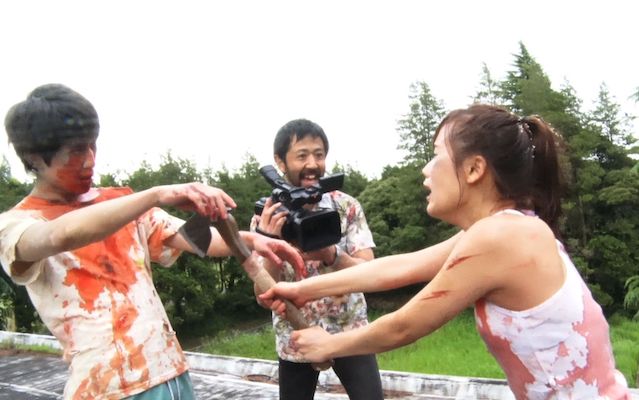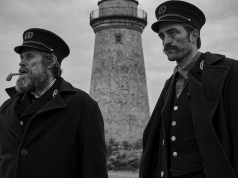
[On Shudder.] •••You can tell pretty quickly that something is up with “One Cut of the Dead.” It starts in an old warehouse serving as the set of an amateurish, low-budget zombie movie, where the director, Higurashi (Takayuki Hamatsu), is having trouble getting convincing performances from his not-very-good actors. During a break in shooting, the makeup artist, Nao (Harumi Shuhama), tells the two young stars (Yuzuki Akiyama, Kazuaki Nagaya) about the urban legend that this warehouse was once the site of military experiments where scientists tried to raise the dead — the very subject of the movie they’re making! Wouldn’t it be something if, while making a zombie movie, actual zombies showed up?? That does happen — we’re still in the first 10 minutes of the movie here — and all hell breaks loose. Higurashi, a seemingly insane gonzo filmmaker, keeps the camera rolling, thrilled to finally be getting authentic-looking terror from his actors.
But something is off. The movie they’re trying to make is cheap and bad, but the one we’re watching — the one about them being attacked by zombies while trying to make a zombie movie — is kind of a mess, too. It’s being done in a single, unbroken take, and it’s obvious when (for example) the camera lingers in one place for too long because they’re waiting for the makeup people to apply fake blood to a victim before the shot can pan back around. These “mistakes” are funny, and our sense of humor tells us they’re here on purpose — but to what end? What is this?
Now consider something else. Think about making a zombie movie with only practical special effects and doing it all in one take. Think of the carefully choreographed frenzy that must take place just off camera, crew members spraying blood, setting up stunts, throwing severed limbs, replacing live actors with butchered mannequins, doing all the behind-the-scenes stuff on the fly (silently!) and then scurrying out of the way before the camera catches them. Wouldn’t you love to see the whole thing from that angle? It would be like being backstage during the production of a merry farce, like the middle act of “Noises Off.”
And that, my friends, is exactly what we get. The nature of what we’ve watched so far is explained, we’re given some backstory, and then we see it again — only now we’re on the sidelines, seeing things from a different angle (literally and figuratively). The backstory we got in between serves as setup: Having seen the punchlines, now we see the context that makes them funny.
It’s a fantastic premise, cleverly constructed and executed by writer-director Shinichiro Ueda and a plucky crew of actors and technicians, many of whom do double duty. The structure requires a little faith and patience — you have to sit through that bad movie-within-a-movie (which could maybe be shorter)– but the payoff is extremely rewarding. I laughed long and loud, often surprised at the jokes that jumped out unexpectedly, where even the setup had been hidden from view. Ueda explores the different kinds of “terror” — the kind you feel when there are zombies chasing you, as well as the kind you feel when you’re an actor being asked to improvise while the cameras are rolling or a director who has discovered one of his actors is a fall-down drunk. (Maybe you could put makeup on him and have him stagger around like a zombie…? Think that would work…?)
You probably get the idea. Ueda probably tries most of the things you’re thinking of. The energy flags a little in the middle section, after we’ve realized what’s going to happen but before we get to it — but, again, patience is a virtue. On top of everything else, it captures the camaraderie and exhilaration of do-it-yourself filmmaking, all the hustle and energy and physicality involved. But mostly it’s just funny.
B+ (1 hr., 36 min.; Japanese with subtitles; )





